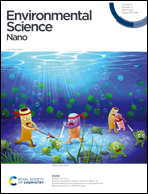Role of NOM–hematite nanoparticle complexes and organic and inorganic cations in the coherence of silica and clay particles: evaluation based on nanoscale forces and molecular self-assembly†
Abstract
The evaluation of the nanoscale forces between a silica probe and hematite nanoparticle (NP) thin layer-coated mica (Hm-mica) in the presence of structurally different natural organic matter (NOM) molecules and inorganic and organic guanidinium (Gd+) cations determines the efficiency of cementing agents towards stable soil aggregate formation. The force–distance curves showed that electrostatic repulsions between the probe and the 5 and 50 mg C per L humic acid (HA)-modified Hm-mica substrates were initiated at higher probe–substrate separations relative to tannic acid (TA)-modified Hm-mica substrates. The abundance of highly ionizable polar carboxylate moieties in HA compared to TA contributed to stronger probe–substrate repulsion. The ion-specific interactions of the weakly hydrated divalent cations with the adsorbed HA diminished the probe–substrate electrostatic repulsion. However, possible exposure of hydrophobic domains contributed to weak adhesion with the silica probe. The maximum adhesion of 0.11 ± 0.04 mN m−1 was recorded in 5 mg C per L HA-modified Hm-mica in the presence of Ca2+. Nevertheless, 50 mg C per L TA modified Hm-mica exhibited a significant increase in adhesion to 1.44 ± 0.5 mN m−1 in the presence of Ba2+. The porous nanostructures produced due to Ba2+-assisted molecular gelation of TA possibly contributed to the strong adhesion. Unlike inorganic cations, organic Gd+ has increased probe–substrate adhesion considerably to 3.13 ± 0.29 mN m−1 in 50 mg C per L HA-modified Hm-mica. The porous nanotubular structures produced by HA in the presence of Gd+ possibly maintained the interfacial water content and facilitated adhesion with the silica probe. Thermodynamic parameters derived from the reactions between the NOM and the cations further supplemented the force data. Therefore, interactions of sesquioxide nanominerals with soil biodegradation products can improve the environmental quality and mitigate the effects of destabilizing forces.



 Please wait while we load your content...
Please wait while we load your content...